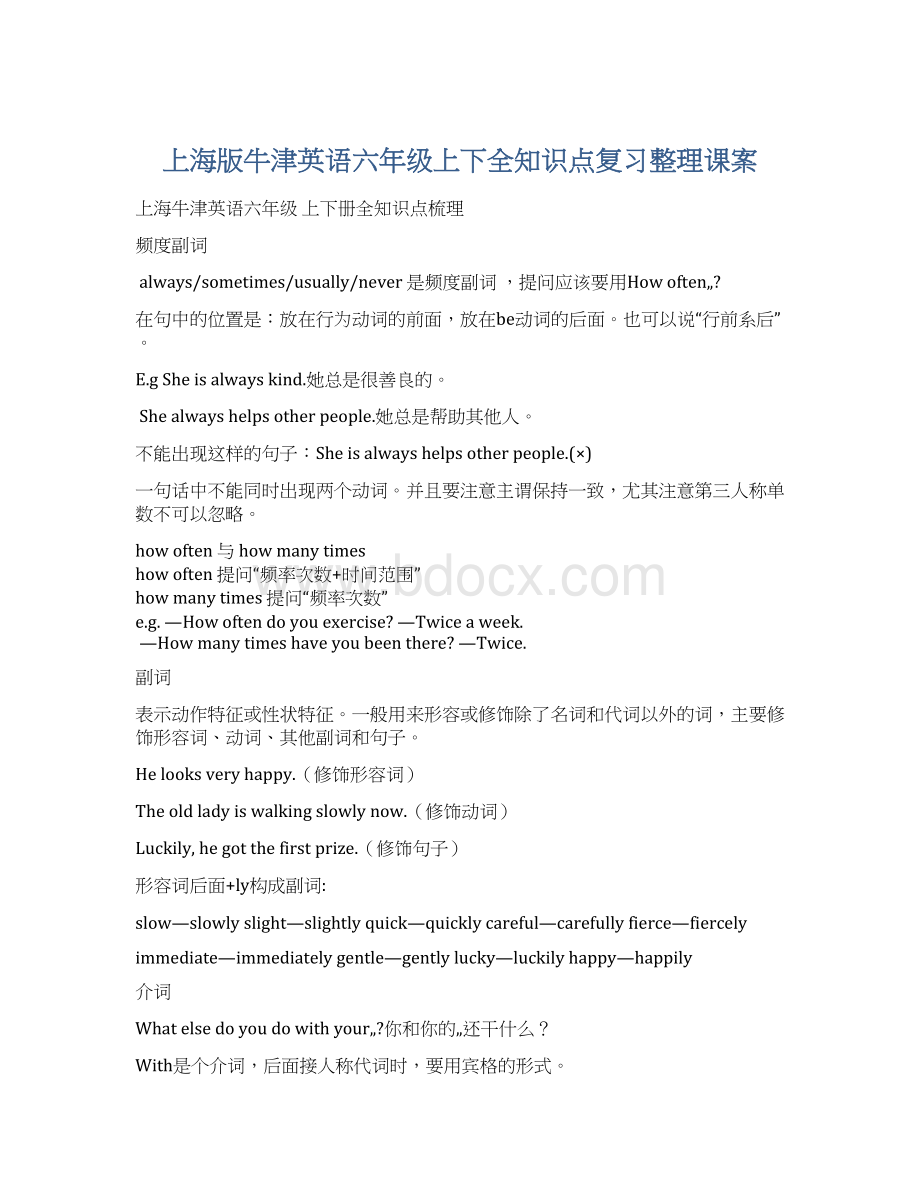 上海版牛津英语六年级上下全知识点复习整理课案.docx
上海版牛津英语六年级上下全知识点复习整理课案.docx
- 文档编号:322123
- 上传时间:2022-10-08
- 格式:DOCX
- 页数:10
- 大小:18.36KB
上海版牛津英语六年级上下全知识点复习整理课案.docx
《上海版牛津英语六年级上下全知识点复习整理课案.docx》由会员分享,可在线阅读,更多相关《上海版牛津英语六年级上下全知识点复习整理课案.docx(10页珍藏版)》请在冰豆网上搜索。

上海版牛津英语六年级上下全知识点复习整理课案
上海牛津英语六年级上下册全知识点梳理
频度副词
always/sometimes/usually/never 是频度副词 ,提问应该要用How often„?
在句中的位置是:
放在行为动词的前面,放在be动词的后面。
也可以说“行前系后”。
E.gShe is always kind.她总是很善良的。
She always helps other people.她总是帮助其他人。
不能出现这样的句子:
She is always helps other people.(×)
一句话中不能同时出现两个动词。
并且要注意主谓保持一致,尤其注意第三人称单数不可以忽略。
howoften与howmanytimes
howoften提问“频率次数+时间范围”
howmanytimes提问“频率次数”
e.g.—Howoftendoyouexercise?
—Twiceaweek.
—Howmanytimeshaveyoubeenthere?
—Twice.
副词
表示动作特征或性状特征。
一般用来形容或修饰除了名词和代词以外的词,主要修饰形容词、动词、其他副词和句子。
Helooksveryhappy.(修饰形容词)
Theoldladyiswalkingslowlynow.(修饰动词)
Luckily,hegotthefirstprize.(修饰句子)
形容词后面+ly构成副词:
slow—slowlyslight—slightlyquick—quicklycareful—carefullyfierce—fiercely
immediate—immediatelygentle—gentlylucky—luckilyhappy—happily
介词
What else do you do with your„?
你和你的„还干什么?
With是个介词,后面接人称代词时,要用宾格的形式。
With me/him/her/it/us /them 在具体的某一楼层只能用介词on,并且第几层还要用序数词 On the ground floor, on the first floor, on the fifteenth floor
具体的某一天介词只能用on
On Sunday, On Sunday morning,On the Open Day
he one on the left/right 左边/右边的这个 the one in the middle 中间的这个
如果是介词短语修饰the one,应该要放在the one后面 ,如果是形容词应放the one的中间the left/right one the middle one
at weekends= at the weekend在周末
现在完成时
现在完成时的构成是:
have/has +动词的过去分词。
have/hasbeento去过,到过(表示现在已经回来)
have/hasbeenin住在=havelived/stayedin
have/hasgoneto去,到…..(表示现在还没有回来)
e.g.WehavealreadybeentoChangfengPark.
IhavelivedinShanghaiforthirteenyears.
Have you been to …..yet?
你去过„..吗?
Yes, I have already/just been to…./been there.是的,我已经去过了。
No, I haven‟t been to …/been there yet.不,还没有去过。
already已经(多用于肯定句,放于动词前)
yet迄今,还(多用于疑问句和否定句,放于句末)
just刚刚(用法和位置和already相同)
e.g.IhavealreadybeentoLily’shome.
HaveyoubeentoLily’shomeyet?
No,Ihaven’tbeentoherhomeyet.
live/stay…for…在…住/待…(时间)
for+一段时间,多与现在完成时连用表示动作从过去延续到现在的一段时间,并用howlong提问。
代词
one用来指代一个人或事物,而ones用来指代一些人或事物。
定冠词the
定冠词the的用法:
a.在球类运动前不加定冠词theplayfootball/basketball/tennis,etc.
b.在乐器前必须加定冠词theplaythepiano/violin,etc.
c.在watchingtelevision中,不加定冠词the
时间表达方式
on the tenth of September / on September tenth 9月10日
two fifteen= a quarter past two 2:
15
Three ten = ten past three 3:
10
One thirty = half past one 1:
30
two forty = twenty to three 2:
40
half an hour=30minutes 用了half an hour后面就不能再有minutes
one and a half hours=one hour and a half一个半小时
One hour and twenty minutes一小时二十分钟
a.m./p.m.分别表示上午和下午。
First,…/Next,…/Then…/After that,…/Finally,…
Finally=at last =in the end
时间状语从句
…when…当...的时候
引导时间状语从句,表示一个动作与另一个动作同一时间发生,或一个动作在另一个动作所延续的范围之内发生。
主从句时态要一致。
当主句用一般将来时,从句用一般现在时代替将来时。
Whatcanyouseewhenthereisatyphoon?
当有台风时,你能看见什么?
Whenitdoesn’traintomorrow,Iwillgooutforawalk.当明天天气不下雨时,我将出去散步。
交通工具
By bus/bike/car/underground/train/ferryride
take a bus/bike/car/underground/train/ferry
He goes to school by bus.=He takes a bus to school.
He goes to school by bike.=He rides his/a bike to school.=He cycles to school.
其他的交通工具都能用take来表示乘,但bike只能用ride a bike
on foot 步行 She goes to work on foot every day.=She walks to work every day.
数词、量词
a few 只能修饰可数名词,与可数名词的复数形式连用 a little 只能修饰不可数名词
some / a lot of 既可修饰可数名词又可以修饰不可数名词。
当与可数名词连用时,只能与可数名词的复数形式连用
Some用在肯定句中,any用于否定和疑问句中。
plentyof“许多,大量”,后面可跟不可数名词或可数名词复数
toomuch太多+不可数名词
toomany太多+可数名词复数
e.g.Don’tdrinktoomuchcola.不要喝太多的可乐。
Toomanysweetsarebadforyourteeth.吃太多糖对你的牙齿不好。
toolittle太少+不可数名词
toofew太少+可数名词复数
可以用not...enough(修饰可数或不可数名词)结构改写句子。
e.g.Youeattoolittlefruit.=Youdon’teatenoughfruit.
less更少+不可数名词(less是little的比较级)
fewer更少+可数名词(fewer是few的比较级)
more更多+可数名词、不可数名词(more是many、much共同的比较级)
e.g.Youshouldhavelessmeat,fewersoftdrinksanddomoreexercise.你应该少吃肉,少喝软饮料,多做运动。
once一次twice两次
三次及以上:
数字+times
aquarterof四分之一threequartersof四分之三
量词:
a slice of /slices of; a tin of/ tins of; a bag of/ bags of; a piece of/ pieces of
问句
How many uncles do you have?
你有多少个叔叔?
How many后面接可数名词的复数形式。
Why do you like„?
你为什么喜欢„„?
I like„because„我喜欢„„是因为„„
Which place shall we visit?
我们将参加哪个地方?
When are we going to come back?
我们将什么时候回来?
What kind of soup/fruit would you like?
你想要哪种汤/水果?
What does this sign mean?
这个标志意味着什么?
What does this sign mean?
=what is the meaning of this sign?
Where can we find it?
我们在哪里能找到它?
Which door must we use?
我们必须要使用哪一扇门?
Would you like rice or noodles for dinner tonight?
你晚饭是想吃饭还是吃面条?
or在这里是标示一种选择关系。
A:
May I have some…,please?
B:
Ok. Here you are./Sorry. I haven‟t got any. May I…?
用于提出请求。
回答时,表示允许,常用Ok。
/Sure./All right./Yes, you may.
表示拒绝时,常用No, you may not./ I‟m afraid you can‟t. 并且may not不能用缩写的形式。
A:
Would you like some…?
B:
Yes, please./No, thanks.
接受别人的请求时,应说Yes, please.;拒绝别人时,应说No, thanks.
I don‟t want any … because it‟s/
- 配套讲稿:
如PPT文件的首页显示word图标,表示该PPT已包含配套word讲稿。双击word图标可打开word文档。
- 特殊限制:
部分文档作品中含有的国旗、国徽等图片,仅作为作品整体效果示例展示,禁止商用。设计者仅对作品中独创性部分享有著作权。
- 关 键 词:
- 上海 牛津 英语 六年级 上下 知识点 复习 整理
 冰豆网所有资源均是用户自行上传分享,仅供网友学习交流,未经上传用户书面授权,请勿作他用。
冰豆网所有资源均是用户自行上传分享,仅供网友学习交流,未经上传用户书面授权,请勿作他用。


 《稻草人》精彩读书笔记精选多篇.docx
《稻草人》精彩读书笔记精选多篇.docx
 每日一学中国急性心力衰竭急诊临床实践指南.ppt
每日一学中国急性心力衰竭急诊临床实践指南.ppt
